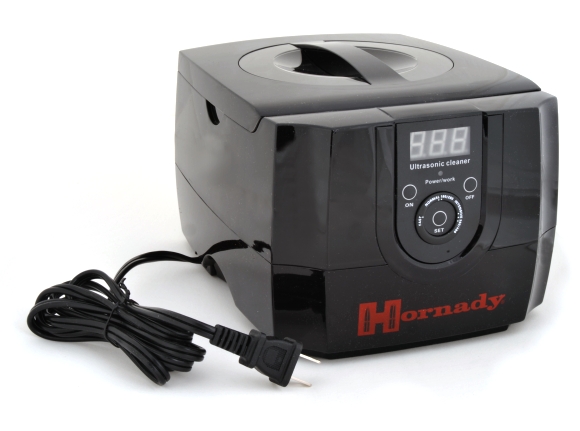
I am always looking for cleaning methods that are not messy and can do a good job with a minimal amount of labor. No, this search is not a function of me being lazy, I just don’t have a lot of free time for tedious, mind numbing work… although it has been suggested that my mind may be particularly suited for exactly that type of employment. When I ran across the Hornady Lock-N-Load Sonic cleaner, I thought it held a good deal of potential for cleaning brass more effectively than a vibratory cleaner, and without the zinc stripping effect of liquid chemical brass cleaners. I also thought it might be good for cleaning small parts like pistol barrels, revolver lock work, bolts, trigger assemblies, etc.
Who is this sonic guy and why is he ultra?
Generally speaking, glop sticks to good material. A proper cleaning solution is used to break the bond between the glop and the substrate. Ultrasonic cleaning, which is actually what the Hornady unit does through cavitation and elevated temperature, assists cleaning solution in breaking the glop/good material bond. Cavitation occurs when sound waves propagate through a liquid in alternating high and low pressure cycles. During the low pressure cycles, voids are created in the liquid… bubbles. When the voids achieve a volume that can’t be sustained, the little buggers implode into a high frequency cycle, forming millions of microscopic jets of water.
At the point of collapse, momentary water jet velocity can exceed 600 MPH, produce more than 29,000 PSI of pressure and rise to a temperature of 8,000+°F. Ultrasonic, the frequency of cycling between low and high pressure, is a term applied to any level above the range of human hearing, typically 20 kHz. Ultrasonic cleaning of the type addressed within this text is best suited to frequencies in the range of 20 – 40 kHz. For the process to function properly, the ultrasonic cleaning process needs to be matched to the application. The use of proper cleaning solution is critical, temperature and time of a cleaning cycle is important, as is choosing the right type and size of ultrasonic cleaning equipment.
Hornady’s Lock-N-Load™ Sonic Cleaner
In the case of the Hornady unit, that low-high cycle is repeated 42,000 times each second. There are high frequency standards such as 80 kHz but, for as counter intuitive as it may seem, they are for lighter cleaning of more delicate items. Heat, within the context of ultrasonic cleaning, is a byproduct of the process. Some ultrasonic cleaners have a built in heater to maintain liquid temperatures between cycles of use. However, a heater is necessary for this type of application. The omission of a heater reduces energy consumption and contributes to the unit’s value pricing. The Hornady unit does have an integral cooling fan to control process generated heat which gives the Lock-N-Load unit extended cleaning cycle capability.
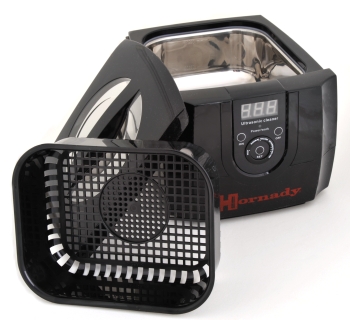 The Lock-N-Load™ Sonic Cleaner employs a single transducer and a 60 watt power supply to produce process ultrasound, with both components combining to assure proper cavitation. Quality ultrasonic cleaners, up through a couple of gallons in capacity, require 200 watts of power for each gallon of capacity. At 2.4 pints, 60 watts is the correct rating for the application.
The Lock-N-Load™ Sonic Cleaner employs a single transducer and a 60 watt power supply to produce process ultrasound, with both components combining to assure proper cavitation. Quality ultrasonic cleaners, up through a couple of gallons in capacity, require 200 watts of power for each gallon of capacity. At 2.4 pints, 60 watts is the correct rating for the application.
The Hornady unit is a direct process cleaner; material, perforated basket and stainless tank are all directly exposed to the same cleaning solution. Indirect process units isolate parts and solution within a container, then that container is immersed in water in that ultrasonic cleaner’s tank. Each method has its own cleaning solution requirements.
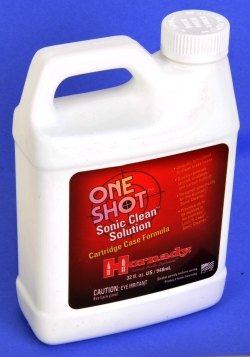 The application for indirect cleaning is when volatile cleaning solutions are required that might cause damage to an ultrasonic unit’s tank or create environmental hazards. This process would not be applicable to the Hornady unit. For direct cleaning, Hornady offers a companion cleaning solution, One Shot that is formulated specifically for cartridge case cleaning.
The application for indirect cleaning is when volatile cleaning solutions are required that might cause damage to an ultrasonic unit’s tank or create environmental hazards. This process would not be applicable to the Hornady unit. For direct cleaning, Hornady offers a companion cleaning solution, One Shot that is formulated specifically for cartridge case cleaning.
A quart of One Shot citric acid based cleaning solution concentrate, when mixed one part solution to forty parts water, provides enough solution for 64 capacity washes. The Lock-N-Load Sonic cleaner tank’s work load capacity is 200 .223 Remington or 100 .308 Winchester cases. That’s a lot of brass, however, the Lock-N-Load™ unit is not limited to brass cleaning as it may be adapted to a number of tasks simply by changing the solution placed in the unit’s tank. Small parts cleaning, pistol barrels and cylinders, trigger assemblies, etc are all within the reach of this compact Ultrasonic cleaner.
An excellent general parts cleaner, that is safe for use in direct cleaning systems, is L&R non-ammoniated Safety Ultrasonic Weapon Cleaning Solution. Sold by Brownells, #515-000-004, the nontoxic concentrate makes eleven gallons of biodegradable cleaning solution, enough to clean lots and lots of parts. Because the cleaning solution contains a strong surfactant, a wetting agent, the solution will more readily penetrate dirt and grime and help the cavitation process to lift it away. I’m not becoming fanatically biodegradable, I just thought being a little careful here might help offset those years of casting lead bullets indoors and putting my hands into solutions that gave them a permanent texture of sandpaper.
In addition to cleaning a variety of materials and assemblies, the Hornady Lock-N-Load Sonic cleaner can be used to lube parts and assemblies as appropriate. The unit works well for this purpose, leaving a durable microscopic protective and lubricating film in even the tightest places. Brownells #083-000-032 Ultrasonic Oil is good for this purpose. All and all, the Hornady Lock-N-Load Sonic Cleaner is compact and flexible in use, making it a nice piece of equipment to have around the shop. The MSRP is a reasonable $134 as is the $99 price tag when purchased through discount retailers like Sinclair International. A quart of One Shot Sonic Cleaning Solution, which makes ten gallons of cleaner, sells for approximately $22 through the same outlets.
So I took it out for a spin…

The Hornady unit has five pre defined cleaning cycles; 90, 180, 280, 380, and 480 seconds – or for those with a minute bias; 1.5, 3.0, 4.6, 6.3, and 8 minutes. The unit can run three consecutive eight minute cycles before a three minute breather is required. The need to clean beyond three cycles would be exceptional.
One part of Hornady One Shot Cleaning Solution was mixed with forty parts of distilled water to make a quart of working solution. That amount is slightly less than the unit’s capacity, but this left some room for the liquid level to rise when brass was added. Distilled water is used because it is devoid of many impurities that might impair cavitation and leave spots or otherwise discolor the finished product. I got into the habit of keeping a few gallons of distilled water in the shop for refinishing or rust removal projects. It’s pretty handy stuff.
Not required by Hornady instruction, however, degassing ultrasonic cleaning solution is good practice. Without this step, gases trapped in the solution can fill ultrasound created bubbles and suppress their implosion. Degassing is accomplished by burping, or letting the unit run with only the solution and basket in place for a few minutes, just until bubbles stop rising to the surface.
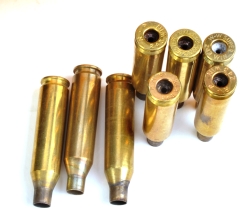
With a .243 Remington project on the way, I dug into my stockpile of used brass and pulled out typical examples, pictured right. They were black at the throat, tarnished and primer pockets were loaded with either black primer glop, or corrosion green fuzz as though they were shot prior to the adaptation of non-corrosive primers. In short, I selected nasty brass to test the Lock-N-Load Sonic Cleaner.
After one cleaning cycle of 480 seconds, the bare brass looked brighter, primer glop remained, as did some of the case neck powder residue. When cartridge cases are laid in the basket horizontally, air is trapped inside which eventually works itself out when exposed to ultrasound. Until that happens, cleaning solution is kept away from the surfaces under the air bubbles, making the first cleaning cycle, or at least a portion of it, the least efficient. With an ambient temperature of 72°F, solution temperature at the end of the first cycle was 78°F. If I had primer pocket brushed before dropping the cases in the tank the first cycle would have been enough.
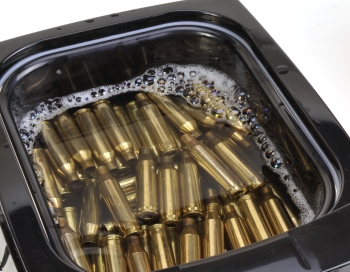 After the second 480 second cycle, cases looked much cleaner and solution temperature rose from 72°F ambient to 102°F. All but the very worst of the cases with fouled primer pockets were quite clean, all of the oxidized primer pockets were clean and the insides of all of the cases were clean.
After the second 480 second cycle, cases looked much cleaner and solution temperature rose from 72°F ambient to 102°F. All but the very worst of the cases with fouled primer pockets were quite clean, all of the oxidized primer pockets were clean and the insides of all of the cases were clean.
At the conclusion of the third and last cycle, all cases were bright and all primer pockets spotless. Solution temperature was 111°F and very black, a change that developed on in this last cycle. The finished cases rinsed off without water spotting.
Results…
The finished product was impressive and process effort was minimal. I went on to use the Hornady Lock-N-Load Sonic Cleaner to clean up more brass, some heavily tarnished bullets then, with the Brownells cleaning solution noted earlier, to clean million machine tooling, the action on an early Thompson Centerfire Contender and a heavily used .45 ACP barrel. When I was done, I emptied the tank, wiped it out with a paper towel and parked the unit on a small piece of work bench real estate.
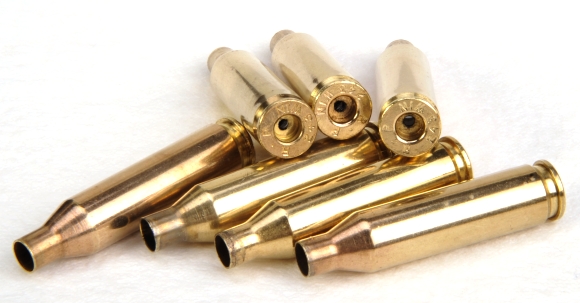
I encountered no problems in use. The controls are simple; on, off and cycle time. The unit can be paused by selecting “Off” with a cycle in process, then restarted by selecting on. The basket lifts out with cleaned material and the Sonic Cleaner’s tank is emptied by pouring out toward the back side of the unit, not the front. About the only thing I would like to see as an improvement is the ability to set a longer overall cleaning time frame, with the unit controlling the necessary starts, stops and pauses without operator intervention. I’d rather set a cycle for twenty four minutes or half an hour and go off and work on something else, then have to start a cleaning cycle every eight minutes. In lieu of that feature, I would settle for a small alarm that marks the completion of a cycle. In a shop with a lot of background noise, it is easy not to notice the unit completed a cycle and shut down. Minor, minor issues. The Hornady Lock-N-Load Sonic Cleaner is a good product, backed by a one year materials and workmanship warranty.

Email Notification